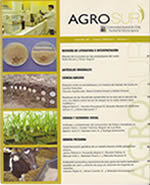Contenido y estabilidad de clorofilas y carotenoides en el zumo de lechuga (Lactuca sativa L.)
Contenido principal del artículo
Resumen
Se estudió la dinámica degradativa de nuevos formatos de consumo de pigmentos antioxidantes para beneficio de la salud humana. Se cuantificó y caracterizó la estabilidad de clorofilas a, b y carotenoides en zumo de Lechuga (Lactuca sativa L.) Cv. Justine durante diez días. Extractos de jugos se conservaron en base a diferentes pH y temperaturas. Se utilizó un diseño experimental ANDEVA con arreglo factorial de 3x3. El primer factor correspondió a la temperatura de almacenamiento del zumo (5, 20 y 35 °C), y el segundo al pH del medio (sin aditivos, 4,5 y 7,5). Diferencias mínimas significativas se midieron utilizando el test de Tukey (α = 0,05).
Se encontraron diferencias significativas sobre concentraciones de los pigmentos entre el factor pH frente al efecto de la temperatura. Los resultados de la interacción de los factores mostraron que las clorofilas a y b y carotenoides, mantuvieron mayor estabilidad en soluciones alcalinas y en condiciones de temperaturas cercanas a los 5 °C, identificándose además variabilidad asociada a las características propias de la molécula. El factor más importante para conservación fue el pH. Los resultados permitieron concluir que existe variación en la degradación de acuerdo al tipo de pigmentos, destacando la clorofila b que tuvo un comportamiento más deseable a temperaturas mayores. En general se evidenciaron disminuciones notorias en la concentración de pigmentos en el zumo desde los tres a cuatro primeros días de almacenaje. Los resultados permiten suponer los tiempos de conservación del zumo y también los momentos de inflexión de la degradación para mejorar el resultado cuantitativo final.

